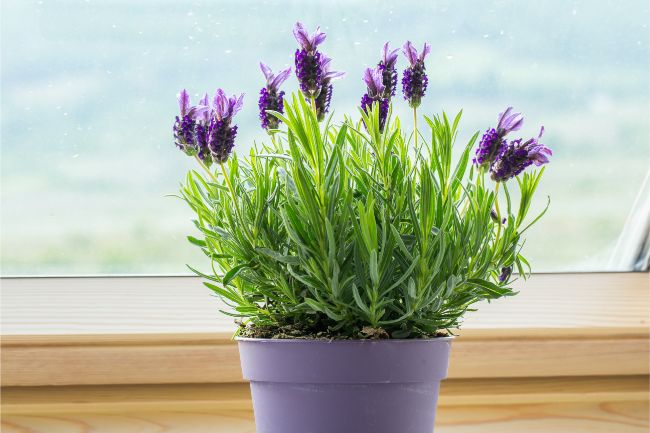Touting beautiful flowers and the revered aromatic scent many people are familiar with, it’s no surprise to see more and more homeowners growing lavender plants indoors. Let’s start with a quick summary of how to care for lavender indoors, before moving on to the details.
How To Care For Lavender Indoors? Position near a window that gets at least 3-4 hours of bright direct sunlight per day and grow in well draining soil to keep your indoor lavender plant healthy. Water once the top inch of soil dries out, fertilize twice per year and provide low humidity and moderate temperatures.
Growing a lavender plant indoors isn’t difficult if you understand the basics do’s and don’ts. Acquaint yourself with the following basics on how to care for lavender indoors and you’ll be rewarded with an incredibly aromatic plant that thrives in your home.
Benefits Of Growing Lavender Indoors
Native to the Mediterranean, the Middle East, and India, lavender’s history dates back more than twenty-five hundred years. It gets its name from the Latin word ‘lavare’, which means to wash.
Ancient Romans used lavender to scent bath water in private and public bathhouses. Its aromatic reputation still follows it to this day, lending itself to culinary, medicinal, and crafting uses.
Culinary: sprigs of foliage or the flowers are used to flavor desserts and drinks such as lemonades, and other alcoholic beverages.
Medicinal: both plants and the essential oils are used as a sleep aid or for stress relief.
Crafting: dried flowers are used to create potpourri, scented satchels, and added to candles, soaps, and bath bombs.
Growing Conditions for Indoor Lavender Plants
Lavender plants are generally easy to grow as long as you give them the growing conditions they need. Let’s look at some of the specifics so you can ensure your lavender thrives indoors.
Light Conditions For Lavender Plants Grown Indoors
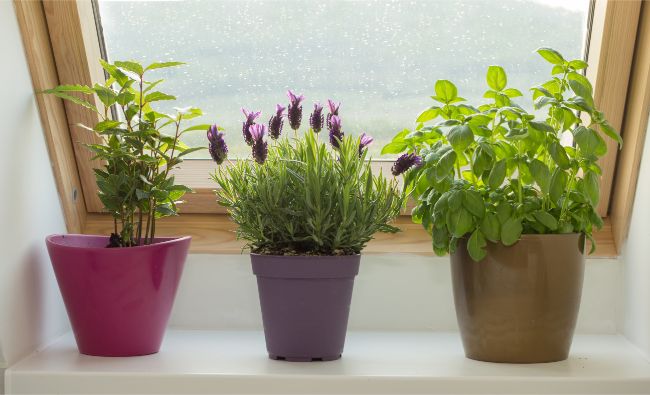
Providing your lavender plants the light they need is one of the most important aspects of growing them indoors. When outside they thrive in full-sun conditions, so they need as much light as possible when grown indoors. Regardless of where you place your plants, rotate the container weekly to promote even growth and flowering.
For the best growth put lavender pots on the windowsill of, or in close proximity to, a south-facing window where they can receive a minimum of 3 to 4 hours of direct sun every day. If you don’t have a south-facing window the next best option is a west window; they get a long period of direct sun but often miss the hottest part of the day.
If you don’t have a south or west window or if your windows are partially shaded it may be necessary to provide supplemental lighting to keep plants from getting too leggy and spindly. Suspend high output T5 fluorescent lamps, compact fluorescent, or full spectrum LED grow lights about 12-inches above your plants.
Temperature For Indoor Lavender Plants
When grown indoors lavender plants need slightly different temperatures at night than they do during the day, and they need cooler temps in the winter versus spring/summer/fall when they are actively growing. These differences in temperature will encourage flowering and strong, healthy foliage growth.
From spring to mid-fall, ideal temps are about 70°F (21°C) during the day and 50-55°F (10-13°C) at night. In the late fall through the winter, temperatures should be 60-65°F (15-18°C) during the day and 45-50°F (7-10°C at night.
Humidity
Unlike tropical houseplants, lavender prefers a low-humidity climate and do best in warm, arid conditions. Most homes have relative humidity levels of about 40 percent which is perfect for growing lavender.
There isn’t any need to add extra humidity to their space with rock trays or grow them in the bathroom for higher moisture levels.
Air Circulation
Allow space between plants for good airflow; if you are growing more than one plant in a single container give them at least 2 to 3-inches of space between each plant for air circulation. This prevents insect pests, as well as fungal and mold problems by encouraging the soil to dry out.
A gentle breeze from an open window a couple of hours each day is optimum. In any season, avoid putting lavender where it is exposed directly to the air from a forced-air vent emitting hot or cold air.
Watering Lavender Plants Indoors
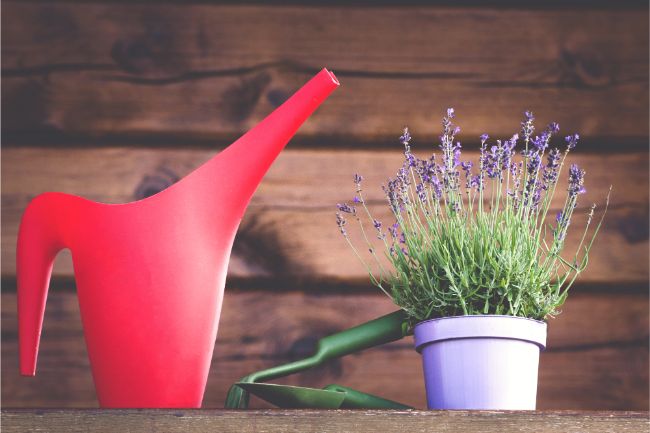
Lavender is native to the Mediterranean and likes to stay on the drier side, as opposed to some plants that prefer their roots to stay moist. The potting soil needs to dry out slightly between waterings but shouldn’t be allowed to dry out completely or you will see yellowing in the leaves. Overwatering will encourage the incidence of root rot, jeopardizing your entire plant.
Using your finger, check soil moisture and water when the top 1-inch of soil is dry. When watered, give enough water to wet the soil thoroughly and then let it go again until the soil dries down. In the winter, lessen the frequency of watering to when the top 2-inches of soil is dry because of slowed plant growth.
Avoid getting water on the foliage, instead directing it onto the potting soil to prevent fungal and mold growth.
I’ve written several articles to help you assess your plants to know when with confidence to water them. Read more about how often to water your plants and the best ways to tell when your houseplants need water.
Fertilizing Lavender Indoors
Just like lavender prefers to almost be ignored when it comes to watering, the same goes for fertilization. In the wild lavender plants thrive in poor soil conditions that many other plants would struggle in.
Too much fertilizer promotes vegetative growth and inhibits flowering, which is ultimately your goal as the flowers are the most aromatic parts of the plant.
To prevent over-fertilization, apply a balanced, water-soluble fertilizer made up at half the recommended strength at the beginning of the growing season and then again in late summer or early fall. I use this fertilizer for most of my indoor plants, and I’ve had great success with it.
If you are repotting your lavender plant, add a small amount of granular, slow-release fertilizer to the potting mix in place of spring fertilization.
Pruning/Harvesting Lavender
Lavender plants should be pruned after the first flowering, and then again in the fall before growth slows for the winter. Remove up to two-thirds of the plant to about the bottom two sets of leaves on the stems being careful not to cut into the woody part of the plant. Pinch back the tops of the plants as needed through the growing season to encourage bushy growth.
To harvest lavender flowers, cut them with a sharp pair of scissors or pruners in early spring right after they open. Gather stalks in your fist and cut them about 2-inches above the woody growth at the base of the plant.
Repotting Indoor Lavender Plants
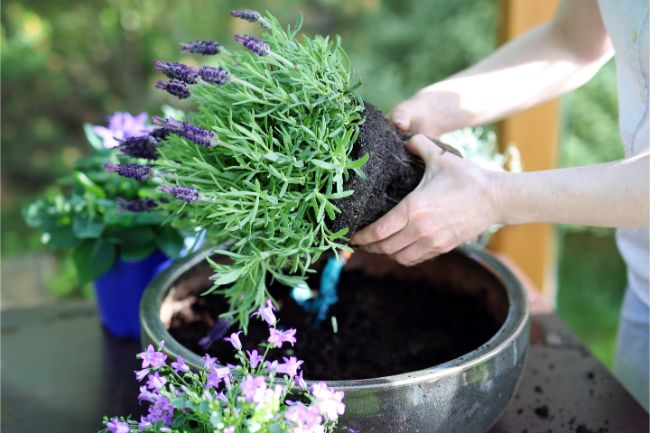
Periodically it’s best to repot your lavender plants to put them into a larger container, and refresh the potting soil.
Frequency
Repot yearly, early in the spring before plants begin actively growing for the season. This allows roots to re-establish and your lavender plant to overcome the stress/shock of replanting with minimum impact on its growth.
Growing Media
Lavender plants like “lean” soil with excellent drainage and prefer a slightly alkaline pH. Look for a commercial potting soil that has excellent drainage capabilities. You can also add extra sand or perlite to promote faster water movement through your containers.
To achieve a slightly alkaline pH with a commercial growing media add a tablespoonful of limestone to the potting mix before filling your container. This will raise the pH slightly above neutral.
Avoid using straight coconut coir or sphagnum peat moss in your containers; they retain too much water.
An important note — when filling containers with growing media do not create a “drainage layer” in the bottom of the pot. For a long time, this was a highly recommended practice, taught to new gardeners. It’s been proven though that this practice is more detrimental than helpful.
As water moves down through the soil profile via gravity, it stops when it encounters this drainage layer created by rocks or small stones. Before the water percolates into the layer, the entire potting soil must fill with water rendering the layer problematic instead of beneficial.
Container Type
Clay or terra cotta pots are the best options as they allow for good airflow and movement through the root zone, allowing the growing media to dry out quickly. Plastic pots will hold too much water.
Opt for pots that are only 1-2” bigger in diameter than the root ball. Lavender likes to be slightly crowded for the best growth. Excess space allows the soil to hold too much water.
Propagating Lavender Indoors
If you want to take your one lavender plant and expand your indoor garden to two, three, or more it’s easiest and cheapest to do it by propagating new plants yourself. Starting new plants from cuttings is the best option since it gives you an exact clone of your existing plant. It is also quicker than starting from seed.
To start new plants from stem cuttings:
- Fill a container(s) with pre-moistened potting soil.
- Take a 4-inch stem cutting from either hardwood or softwood foliage. Remove all of the leaves from the bottom 2 inches of the stem and lightly scrape the skin off the bottom portion of one side.
- Create a hole in the potting soil slightly deeper than the cutting.
- Carefully place it in the potting soil, making sure to fill the hole in gently.
Cuttings should root in approximately three to four weeks; hardwood cuttings may take slightly longer.
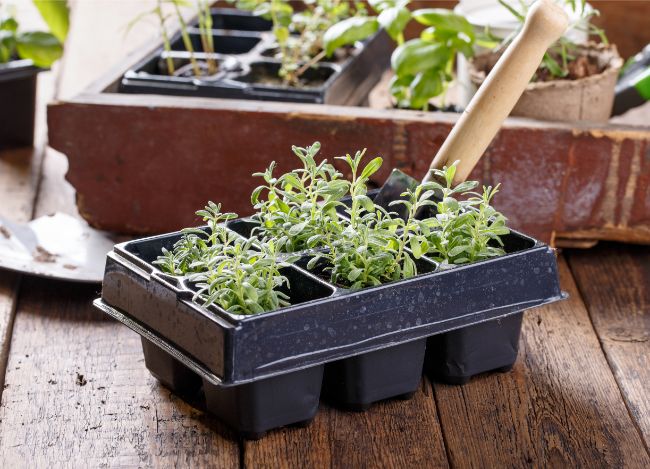
Pests & Disease Problems With Lavender Grown Indoors
Lavender plants are generally considered hardier than many other perennials, but they still fall prey to a few insect and disease problems. Monitor your plants frequently to catch problems early and treat them before damage is extensive.
Insects
Lavender plants don’t attract many insect pests because of their powerful scent, but you can have problems with spittlebugs, aphids, and whiteflies.
Spittlebugs
Spittlebugs are known for the frothy masses of spittle they produce when sucking sap from lavender plants. They pump bubbles into the foamy substance secreted during feeding; the spittle mass then encompasses the nymphs, protecting them from drying out or being attacked by enemies. In most cases, a spittlebug infestation is not damaging to your plants.
The best way to get rid of them is to remove them by hand; pesticides are ineffective as the spittle protects the nymphs.
Aphids
Aphids are one of the most common insects affecting indoor plants. These tiny, pear-shaped insects attach themselves to the plant sucking sap and then secreting “honeydew”. Symptoms appear as distorted foliage and leaf drop.
Remove aphids by wiping the plants with a clean, soft cloth or spraying the plants with a mild solution of water containing a few drops of dish soap.
Whiteflies
Whiteflies are closely related to aphids and are often mistaken for tiny white moths. They are usually pale in color and are covered with a powdery whitish wax; both nymphs and adults suck sap, leaving honeydew behind. Symptoms include stunting and yellowing of leaves, followed by leaf drop.
They quickly take to flight when the host plant is disturbed, making them hard to treat. Hand removal is best or spray plants with a strong stream of water. I’ve written another article about the best ways to get rid of houseplants naturally, if you want to learn more about keeping your plants free of all pests.
Diseases
The common diseases seen in lavender are root rot, alfalfa mosaic virus, and shab.
Root Rot
The most commonly seen problem with lavender is root rot, caused by overwatering, especially in the winter months. The roots then die back due to lack of oxygen or the overgrowth of a soil fungus.
Soggy soils encourage the growth and multiplication of Pythium, Phytophthora, Rhizoctonia, or Fusarium fungi which spreads into the roots, infecting plants.
Healthy roots begin to turn brown and mushy as they perish, unable to take in nutrients needed for growth. As root rot progresses leaves turn yellow, wilt, or droop and then become mushy as well. Once symptoms are visible in the leaves the problem may be past the point of rectifying, endangering the entire plant.
The challenge with root rot is that it often goes unnoticed because it occurs beneath the soil surface and out of sight. In extreme cases when conditions are perfect, i.e. in pots without drainage holes, root rot can kill the whole plant within ten days.
If caught soon enough you can repot the plant, to try to save it. Remove as much of the infected soil as possible adding in fresh, clean potting soil. If root rot has spread significantly, dissect the plant, keeping only the healthy portions. If the whole base is affected, take stem cuttings from healthy foliage to propagate a new plant.
Alfalfa Mosaic Virus
Found worldwide infecting many nightshade and legume plants, alfalfa mosaic virus can also be found in almost every commercial lavender producing operation. Infection results in yield losses, a reduced ability of the plant to overwinter, and increases susceptibility to other diseases. Symptoms show as distorted yellow leaves or blotches that appear in a mosaic pattern.
The virus is typically spread by aphids, so watching for aphid infestation is important. Once plants show signs of infection there is little that can be done for treatment.
Shab
Out of nowhere, Shab takes over and kills the stems of lavender plants. This fungus wreaks havoc on lavender plants even when there is no drought or any other stressors. Very small black specks appear on the stems of the plant, followed shortly by wilting as the fungus saps the plant of its strength.
Unfortunately, once shab sets in there is little that can be done for treatment. Cut away infected parts of your lavender plant or destroy the entire plant.
Related Questions
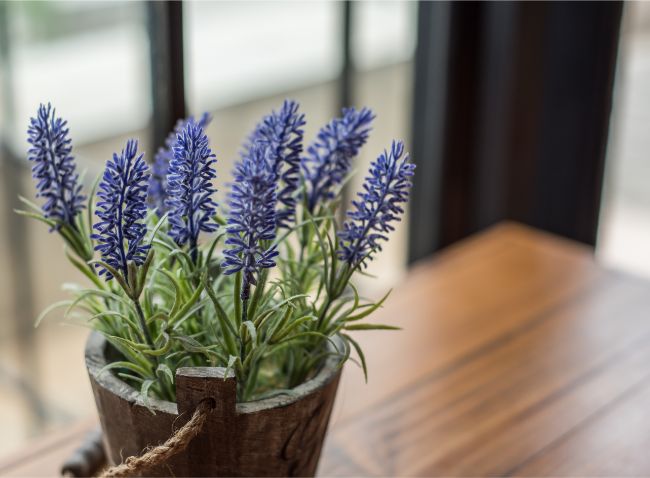
What is the difference between French, English, and Spanish lavender?
- All three are related but have different characteristics. French lavender isn’t as common as English lavender, has a softer scent, and its blooms last much longer than the other types. English lavender is the most common: it has the most aromatic flowers and is the most cold tolerant. Spanish lavender has the softest scent and is usually used for landscaping instead of oil production.
Can my indoor lavender plants be moved outside?
- Yes, your lavender plant can be moved outside and may benefit from it. Due to its high light requirements, lavender plants do well when allowed to live outside during the hot summer months when the days are long. They are not cold-tolerant though so make sure to bring them back in before temperatures drop too low in the fall.
What plants can be grown with lavender?
- The best plants to grow with lavender are those needing similar growing conditions: oregano, sage, thyme, rosemary, bay, marjoram, echinacea, and aster.
If plants are overwatered, is it possible to remediate the problem?
- The best way to correct overwatering is to repot the plant immediately. During the repotting process gently remove some of the waterlogged soil from the root ball, replenishing it with fresh, new soil that has good drainage capabilities.
Are lavender plants toxic?
- Lavender plants are considered non-toxic. Under most conditions, they present little threat to humans or pets if consumed, although they can cause stomach upset if a great deal of plant material is ingested. The concern lies with lavender oil, as that is toxic in large amounts. I’ve covered some of my favorite non-toxic houseplants in this article, if you are looking for other options that are safe for your pets and children.

